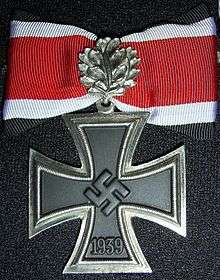Werner Baumbach
| Werner Baumbach | |
|---|---|
|
Werner Baumbach | |
| Born |
27 December 1916 Cloppenburg, Lower Saxony |
| Died |
20 October 1953 (aged 36) La Plata, Argentina |
| Allegiance |
|
| Service/branch |
|
| Years of service | 1936–45 |
| Rank | Oberst |
| Unit | KG 30, KG 200 |
| Commands held | 5./KG 30, I./KG 30, KG 200 |
| Battles/wars | World War II |
| Awards | Knight's Cross of the Iron Cross with Oak Leaves and Swords |
| Other work | Test pilot |
Werner Baumbach (27 December 1916 – 20 October 1953) was a bomber pilot in the German Luftwaffe during World War II and commander of the secret bomber wing Kampfgeschwader 200 (KG 200). He received the Knight's Cross of the Iron Cross with Oak Leaves and Swords for the destruction of over 300,000 gross register tons (GRT) of allied shipping.[1]
Career
Baumbach entered the Luftwaffe in 1936 and after first training at the 2nd Air Warfare School (RAF Gatow|) was trained as a bomber pilot. He was one of the first pilots to fly the Junkers Ju 88 bomber and flew various bombing missions with Kampfgeschwader 30 (KG 30). On 19 April 1940 he bombed and damaged the French cruiser Émile Bertin for which he was awarded the Iron Cross 1st Class.[1] In 1942, Baumbach was removed from active pilot duty and started working on new bomber designs; among others, he helped design the composite bomber system Mistel. In 1944, he was placed in command of the newly formed Kampfgeschwader 200 (KG 200) and was in charge of all Luftwaffe special missions. Baumbach was promoted to Oberstleutnant on 15 November 1944 and was tasked with leading the affairs of the General der Kampfflieger.
After the war, Baumbach spent three years as a prisoner of war before he moved to Argentina where he worked as a test pilot. He died in a plane crash on 20 October 1953 while evaluating a British Lancaster bomber. He was interred in his hometown Cloppenburg.[2]
Awards
- Front Flying Clasp of the Luftwaffe for Bomber Pilots in Gold with Pennant "200"
- Pilot/Observer Badge in Gold with Diamonds (14 July 1941)[3]
- Iron Cross (1939)
- Knight's Cross of the Iron Cross with Oak Leaves and Swords
- Knight's Cross on 8 May 1940 as Leutnant and pilot in the 5./KG 30[4]
- 20th Oak Leaves on 14 July 1941 as Oberleutnant and Staffelkapitän of the 1./KG 30[4]
- 16th Swords on 17 August 1942 as Hauptmann and Gruppenkommandeur of the I./KG 30[4]
- Mentioned twice in the Wehrmachtbericht on 14 February and 28 February 1941
References
Citations
Bibliography
- Berger, Florian (1999). Mit Eichenlaub und Schwertern. Die höchstdekorierten Soldaten des Zweiten Weltkrieges [With Oak Leaves and Swords. The Highest Decorated Soldiers of the Second World War] (in German). Vienna, Austria: Selbstverlag Florian Berger. ISBN 978-3-9501307-0-6.
- Scherzer, Veit (2007). Die Ritterkreuzträger 1939–1945 Die Inhaber des Ritterkreuzes des Eisernen Kreuzes 1939 von Heer, Luftwaffe, Kriegsmarine, Waffen-SS, Volkssturm sowie mit Deutschland verbündeter Streitkräfte nach den Unterlagen des Bundesarchives [The Knight's Cross Bearers 1939–1945 The Holders of the Knight's Cross of the Iron Cross 1939 by Army, Air Force, Navy, Waffen-SS, Volkssturm and Allied Forces with Germany According to the Documents of the Federal Archives] (in German). Jena, Germany: Scherzers Militaer-Verlag. ISBN 978-3-938845-17-2.
- Schumann, Ralf (2007). Die Ritterkreuzträger 1939–1945 des LG 1 (in German). Zweibrücken, Germany: VDM Heinz Nickel. ISBN 978-3-86619-013-9.
- Die Wehrmachtberichte 1939–1945 Band 1, 1. September 1939 bis 31. Dezember 1941 [The Wehrmacht Reports 1939–1945 Volume 1, 1 September 1939 to 31 December 1941] (in German). München, Germany: Deutscher Taschenbuch Verlag GmbH & Co. KG. 1985. ISBN 978-3-423-05944-2.
| Military offices | ||
|---|---|---|
| Preceded by Oberst Heinz Heigl |
Commander of Kampfgeschwader 200 15 November 1944 – 6 March 1945 |
Succeeded by Major Adolf von Hernier |

